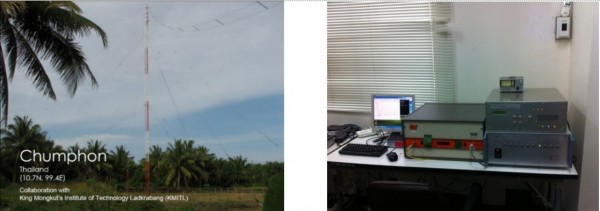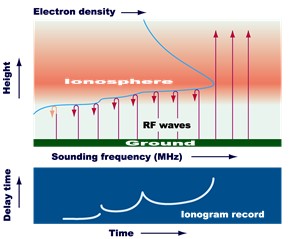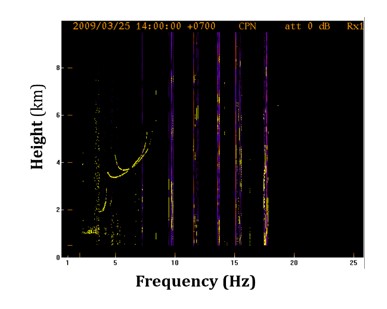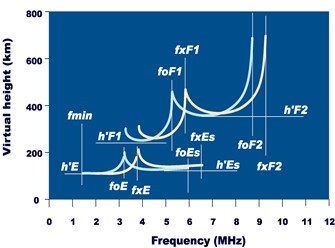The upper atmosphere from about 50 km up to 1,000 km altitude is called “ionosphere.” The ionizing action of the sun’s radiation produces sufficient free electrons in this region, which affects the radio wave propagation.
The ionosphere is divided into 3 layers:
- D (60-90 km)
- E (90-150 km) and
- F (150-500 km) layers.
The F layer is separated into F1 and F2 layers in the daytime. The F2 layer is the important part of the ionosphere and the applications in high frequency (HF) communications as well as GPS navigation accuracy.
 |
| (a) Ionosphere sounding antenna (b) FM/CW ionosonde |
| Fig. 1. Ionospheric observation at Chumphon station (a) ionosphere sounding antenna (b) frequency-modulated continuous wave (FM/CW) ionosonde. |
Fig. 1 (a) and (b) show the ionospheric observation by the frequency modulated-continuous wave (FM/CW) ionosonde at Chumphon station (10.72°N, 99.37°E), Thailand. This station, located on Chumphon campus of King Mongkut’s Institute of Technology Ladkrabang (KMITL), is a part of the Southeast Asian Low-Latitude Ionospheric Observation Network (SEALION) project since 2005. For observation, the radio wave in the range 2-30 MHz is transmitted from the FM/CW ionosonde to the ionosphere by the ionosphere sounding antenna. The reflected pulse is received and its delay time is recorded as a trace on the ionogram as shown in Fig. 2 and 3, respectively [1].
 |
| Fig. 2. Ionospheric observation technique (ionosonde). |
 |
| Fig. 3. Sample of ionogram. |
 |
| Fig. 4. Schematic illustration of ionogram and ionospheric parameters. |
The schematic illustration of ionogram and ionospheric parameters are shown in Fig. 4. The ionospheric parameters for the operation of HF communication system are
- the F2 layer critical frequency (foF2)
- the maximum useable frequency reflected from the F2 layer which can be received at a distance of 3,000 km (MUF3000F2) and
- the F2 peak electron density height (hmF2) [2].
For this station, the foF2 and MUF factor are manually scaled (extracted, measured) from the ionograms (for station with digital ionosonde, these parameters are automatically scaled). The M3000F2 and hmF2 can be computed in Eq.(1) and (2), respectively.
The F2 layer peak height (hmF2) is the F2 peak electron density height (km), computed using the expression [2]
References:
[1] Maruyama, T., Kawamura, M., Saito, S., Nozaki, K., Kato, H., Hemmakorn, N., Boonchuk, T., Komolmis, T., Ha Duyen, C., Ann. Geophys. 25, 1569–1577, 2007.
[2] Shimazaki, T. Word daily variability in the height of the maximum electron density of the ionospheric F2-layer. J. Radio Res. Labes. (Jpn.) 2, 85–97, 1955.
[3] Abdu, M.A., Outstanding problems in the equatorial ionosphere–thermosphere system relevant to spread F. J. Atmos. Sol. Terr. Phys. 63, 869-884, 2001.
[4] Piggott, W.R., Rawer, K., second ed. Elsevier, New York, 1972.
[5] Klinngam, S., Supnithi P., Rungraengwajiake S., Tsugawa T., Ishii M., and Maruyama T., Adv. Space Res., 55, 2139-2147, 2015.

